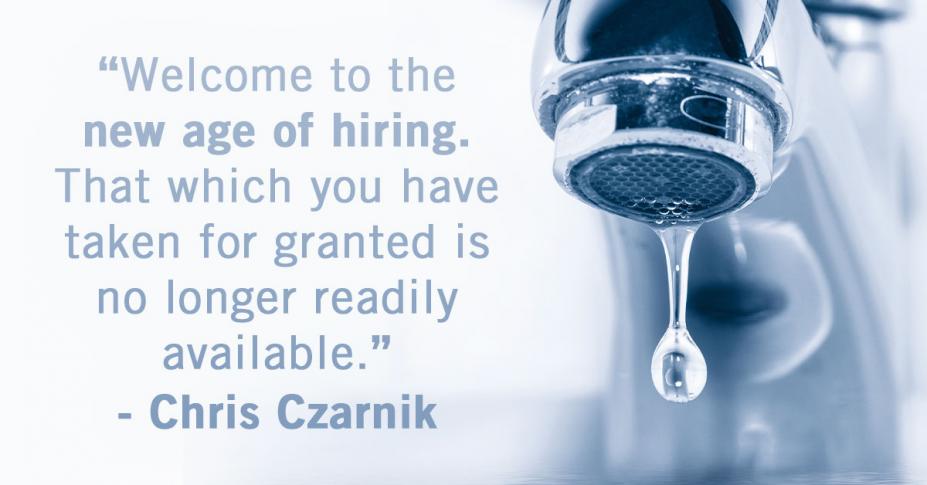We use cookies to optimize our website. By continuing to use the website, you agree to the use of cookies. Further information about the cookies can be found in our privacy policy. Learn more.
Posts tagged 'chris czarnik'
What is the REAL Cost of Turnover?
For most businesses, and people for that matter, they will continue to do the same things each day until there is some reason to change. The basis for psychology is that “people move towards pleasure and away from pain.” This explains why very little changes in an organization until the pain of doing nothing is greater that the pain of doing something. It is with this as the backdrop that we discuss the cost of an open position in an organization verses the cost of changing the way that you recruit, engage and develop talent in your organization.
The cost of an open position is a “hidden cost” for most organizations. In the very short run, an open position costs less money to the direct payroll costs so it can be naively seen as a net positive. It is only when we put a number to the vacant position that we have something to balance that with.
This cost is actually quite easy to come up with. If you look at all of your product and service costing models you will likely have categories of fixed and variable expenses. You will also have the amounts that you charge customers for the services of each employee that they interact with. Your pricing and costing models are the key to coming up with this number.
Say that you are a roofing company and you currently have three open positions for hands on roofing technicians. Each of those technicians you pay $20.00/hour (for easy figuring). Is the cost of an open position then $20.00/hour or roughly $42,000/year? NO. If you look at your pricing model you will note that you CHARGE customers $40.00/hour for each technician’s time. So the cost of this open position is more like $80,000/year. Add to that the fact that in order to get the job done for the customer you need to pay your current employees’ overtime to finish on time. What is the cost of that?
The last hidden cost that you need to consider is the effect on your employee retention that having open positions creates. An open position means that someone else must do the work that is undone because of this open position. People will take on more work or work overtime for a short period of time but eventually if they see no light at the end of the tunnel they will leave and create ANOTHER open position.
So, is it worth your time to change the way that you recruit, engage and develop employees? I’ll just let YOU do the math…
-Chris Czarnik, author of Winning the War for Talent; originally posted on chrisczarnik.com
To read more about recruiting and retaining the best employees, check out Winning the War for Talent>>
Are People Unwilling or Unable to Work for You?
I’m a binary guy. I like 0’s and 1’s. I like on and off. I like yes and no. I LOVE light switches…but dimmer switches confuse me. Getting to a binary question seems like the only way to start a problem-solving process. And so it is with figuring out why people are NOT applying for your open positions.
It might be helpful to define terms here:
UNABLE: lacks the physical or mental capability to take an action. A person may be highly motivated to take the desired action but cannot due to these limitations. Impossible to complete the action.
UNWILLING: May be both physically and mentally capable of performing the desired action but lacks sufficient motivation to do so. Has made a value-based decision to not take the action.
Now let’s ask the question again. If people are not applying for open positions in your organization are they UNWILLING or UNABLE to do so? The ramifications of answering this question will have a profoundly positive impact on your hiring practices. More importantly, do you know which of the two it is?
If people are UNABLE to apply for open positions at your organization, that falls into one of two categories. First: The person is not aware of your organization. They have never heard of it, have never interacted with it and unless something changes will never interact with it. People cannot apply for a position at a company that they don’t know exists. As hard as it is to believe, about 70% of people eligible to apply for your positions fall into this category.
The second possibility is that people are not applying because they have some FALSE preconceived notion about working for you. It may be that they have made or heard negative things about your industry. Maybe their information is inaccurate or completely out of date. It doesn’t matter. Unless you actively change these misconceptions about your organization in the community, people will cling to them and not apply in droves. About 20% of job seekers fall into this category.
If people are UNWILLING that is quite another matter. This would mean that the person knows about your organization, has accurate information about working for you and has made a VALUE-driven decision not to apply for your position. While this happens, through my work with thousands of job seekers, I can tell you that only about 10% of job seekers fall into this category.
How can you find out which is true for your organization? Simple. Just ask your current employees what made them aware of your organization for the first time. Did they drive past you? See a sign? See a job ad? Get referred from a friend?
And about that false preconceived notion about your company or your industry….ask them about that as well. Did they have a wrong idea about your organization before they came to work for you?
Knowing the answers to these questions will help you decide what steps to take to change the number and fit of the people applying for your positions. All of these answers lie with your current employees. It's time to ask them for some guidance.
-Chris Czarnik, author of Winning the War for Talent; originally posted on chrisczarnik.com
To read more about recruiting and retaining the best employees, check out Winning the War for Talent>>



